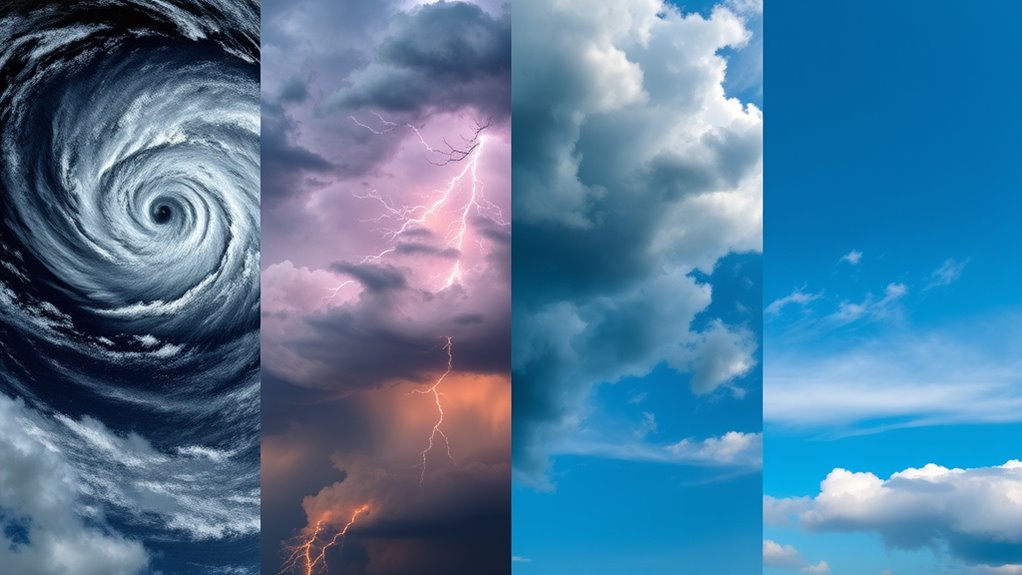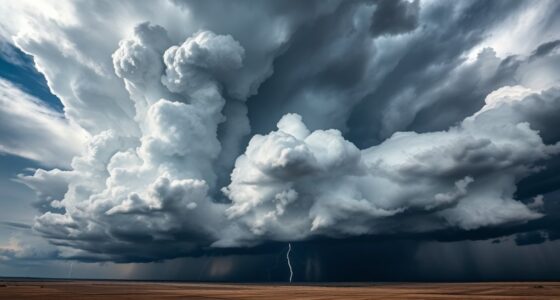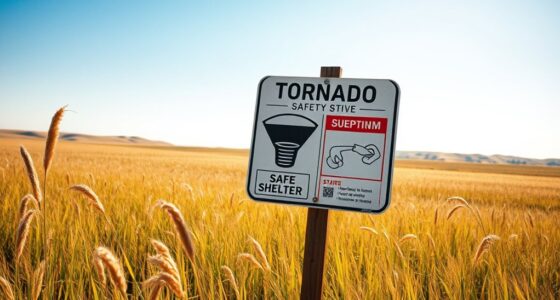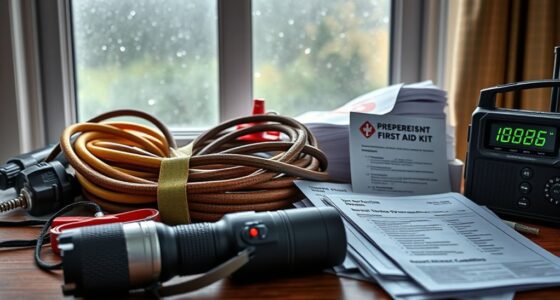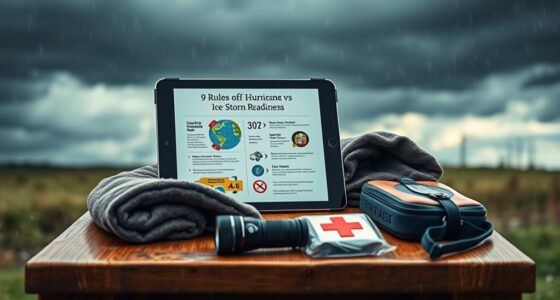When a storm approaches, act according to its category—stay indoors and secure loose objects during weaker storms, but seek shelter and follow evacuation orders during more severe ones. Avoid driving in flooded areas and keep emergency supplies ready. Recognizing the storm’s level helps you take appropriate safety measures to minimize damage and stay safe. Keep informed with official updates; if you want to know exactly what each category means and how to prepare, keep exploring.
Key Takeaways
- Do stay indoors and secure outdoor objects during severe storms; don’t leave windows or doors unsecured.
- Do monitor official weather updates; don’t rely solely on social media or unverified sources.
- Do stock emergency supplies like water, food, and first aid kits; don’t wait until the storm is imminent to prepare.
- Do seek shelter in designated storm-safe areas during high-category storms; don’t attempt to drive through flooded or debris-filled roads.
- Do follow evacuation orders promptly; don’t delay or ignore safety warnings to reduce risk of harm.
Understanding Storm Categories and Their Impacts

Understanding storm categories helps you prepare and respond effectively. Storm safety depends on knowing the differences between tropical storms, hurricanes, and typhoons, and how their intensities influence potential damage. Weather warnings are issued based on these categories to alert you about possible risks. For example, a Category 1 hurricane may bring minor damage, while a Category 5 could cause catastrophic destruction. Recognizing these distinctions allows you to follow appropriate precautions and stay informed. The severity levels of storms directly correlate with the amount of damage they can inflict. Knowing what each storm category signifies guarantees you take the right steps to protect yourself and your loved ones during severe weather events. Stay alert, stay safe, and always heed official weather warnings.
Do’s and Don’ts for Different Storm Levels

Knowing what to do and what to avoid during different storm levels can substantially reduce your risk of injury or damage. Prioritize storm safety by staying indoors and securing loose objects outside during severe storms. Avoid driving through flooded areas or attempting to move debris, as these actions increase danger. Keep emergency preparedness supplies handy, including water, flashlights, and a first aid kit. For lower-level storms, stay alert and monitor weather updates, but don’t let complacency compromise safety. Never ignore official warnings or underestimate a storm’s potential. During any storm, remaining calm and following recommended safety protocols helps protect you and your loved ones. Properly understanding storm levels and adhering to these do’s and don’ts can make all the difference in staying safe. Silky tantrums often occur during family photoshoots, adding unexpected humor to the situation.
Preparing and Responding Based on Storm Severity
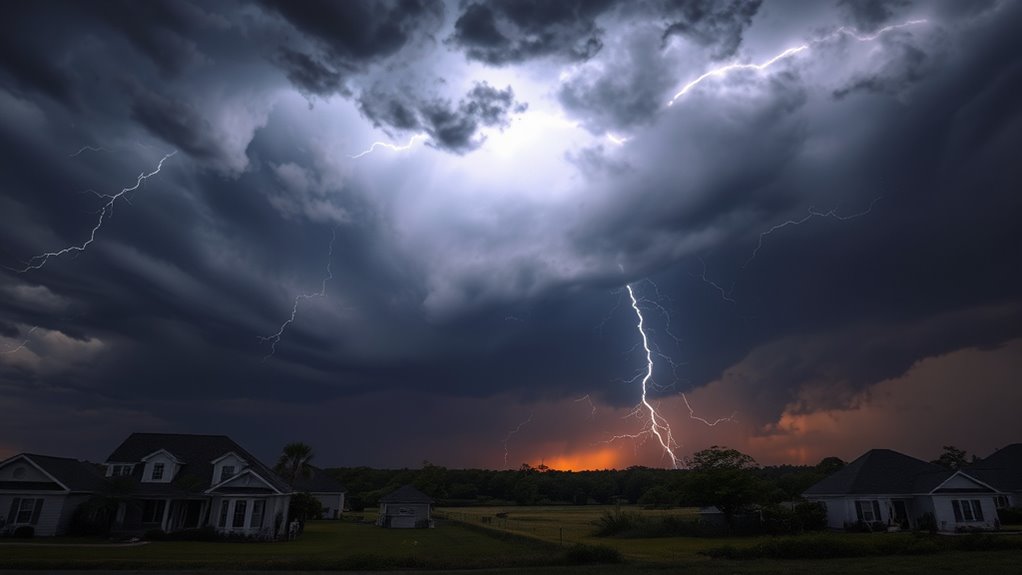
How you prepare and respond varies considerably with the storm’s severity. For minor storms, guarantee your emergency kit is stocked with essentials like water, non-perishable food, and medications. Keep an eye on weather alerts and secure loose outdoor items. If a storm escalates to a severe level, seek shelter in a designated storm shelter or the safest area of your home, away from windows. Make sure your storm shelter is accessible and equipped with supplies. Stay informed through weather updates and follow evacuation orders if issued. During the most intense storms, don’t hesitate to move to your storm shelter immediately. Preparation, such as having an emergency kit ready and knowing your shelter’s location, can make a critical difference in your safety. Additionally, understanding storm categories can help you better assess the level of threat and prepare accordingly.
Frequently Asked Questions
How Are Storm Categories Officially Classified?
You can understand storm classification through official weather warning systems that categorize storms by their wind speeds and potential damage. These systems, like the Saffir-Simpson scale for hurricanes, assign categories to help you prepare and respond appropriately. By paying attention to these classifications, you get a clear idea of the storm’s severity, enabling you to stay safe and follow recommended precautions during severe weather events.
What Are Common Misconceptions About Storm Severity?
Many believe that a hurricane’s category alone determines its danger, but that’s a severity myth. Storm myths often lead you to underestimate a storm’s potential impact, regardless of its classification. Remember, even lower-category storms can cause severe flooding and damage. Your perception should focus on local warnings and preparedness, not just storm myths or the storm’s label. Always stay informed and respect every storm’s unique threat level.
Can Storm Categories Change Rapidly?
Yes, storm categories can change rapidly due to fluctuations in storm scale and intensity. As a storm gathers strength or weakens, its category on the storm scale may shift quickly, especially with factors like wind speed and pressure changes. You should stay alert for updates, as category fluctuations can occur within hours, impacting safety measures and preparedness. Monitoring official forecasts helps you respond promptly to these rapid changes.
How Do Storm Categories Affect Insurance Policies?
Sure, storm categories influence your insurance policies more than you think. When a hurricane climbs the scale, your storm insurance might call for policy adjustments—higher premiums or stricter coverage, perhaps. So, if a Category 5 looms, expect your insurer to tighten the purse strings. It’s like storm severity whispers in their ear, nudging them to reconsider what’s covered and what’s not, all to protect their bottom line.
Are There Long-Term Health Effects From Storm Exposure?
Exposure to storms can cause long-term health effects, such as respiratory issues from mold and dampness or mental health challenges like anxiety and PTSD. Storm health risks include infections from contaminated water and injuries from debris. You should take precautions, like seeking medical attention promptly and avoiding moldy areas, to minimize these long-term effects. Being aware of storm health risks helps you stay healthier long after the storm passes.
Conclusion
By understanding storm categories, you can react appropriately and stay safe. For instance, if a hurricane warning is issued, you’ll know to secure your home and follow evacuation orders. Remember, each storm level demands different actions, so stay informed and prepared. When you respond proactively, you minimize risks and protect your loved ones. Stay vigilant, respect storm warnings, and you’ll navigate storm seasons with confidence and resilience.
